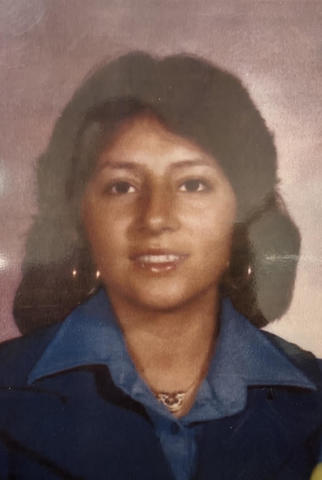Santa Clara County investigators announced they have solved a 44-year-old cold case homicide 15 years after the killer’s death.
Deputy District Attorney Rob Baker said county investigators and Sunnyvale detectives used DNA from crime scene evidence that had been uploaded into a national database to conclusively identify Sam Silva of Colorado as the man who fatally stabbed Elena ‘Estella’ Mena during a rape attempt at her place of work in Sunnyvale in 1979.
Silva died in 2008 in a Colorado prison while serving a sentence on a gun charge.

Victim Elena “Estella” Mena was murdered in 1979. Photo from the Santa Clara County District Attorney’s Office.
Mena was on the job as a security guard when she was attacked by Silva on Oct. 27, 1979, Baker said. He said Silva likely had met Mena previously, when both worked at Great America. Silva and his victim were both 18 years old at the time of their deadly encounter.
An office worker had interrupted the attack, causing the suspect to flee. Mena’s killer remained unidentified until a new DNA analysis in 2023 by the Santa Clara County Crime Lab of blood on her shoes and clothing in the evidence file from 1979.
The blood samples collected at the crime scene enabled the DA’s Cold Case Unit to crack the case.
Baker said the Mena murder was one of the first cases the Cold Case Unit looked into after District Attorney Jeff Rosen established it in 2011.
He told San Jose Inside that after crime scene investigators collected about 30 items at the scene of the 1979 crime, “the only DNA we got was the victim and an unknown male from blood on the doorframe.” The DNA from the blood samples were uploaded into the FBI’s Combined DNA Index System (CODIS) in 2011 and used to create a profile of the suspect, but no match was found, Baker said.
The lab also collected various hairs, and in 2015, the hair samples were sent to the California Department of Justice. These also did not yield any positive identification, Baker said..
“Not getting any profiles from the evidence tested in 2011 is not surprising since analyzing mixtures and degraded samples was far more challenging back than it is today,” the prosecutor said.
Then, in 2022, investigators got a big break. The cold case unit used genealogy to identify the source of the doorframe blood and match it to blood on the victim’s clothing.
“Once we identified the source, we used new technology to try and get a profile from the victim’s clothing to see if it matched the doorframe guy,” Baker said. “Much of the victim’s clothing was already tested in 2011, so in 2023 we sampled different items/parts that had not been previously tested, knowing that our instruments are more sensitive now.”
“From this exam in 2023, our lab developed Silva’s profile,which got a hit with CODIS.”
Baker said Silva had been staying with family members in Santa Clara County at the time of the killing, and fled back to Colorado after the killing. Silva had a criminal history of manslaughter, attempted murder, assault with a deadly weapon, rape, and firearms offenses.
Silva’s DNA was collected and uploaded to the CODIS database CODIS in 2006, two years before his death. “DNA technology was not sufficiently developed to identify him before he died,” said Baker.
Since 2018, the DA’s Office Cold Case Unit has solved 16 cold case homicides and 10 sexual assaults. Four of those murders were solved with the use of forensic genealogy.
“Once we got the CODIS hit from the victim’s clothing, Sunnyvale Public Safety Det. Matthew Hutchison went out to Colorado for several days to conduct follow up interviews,” Baker said. “He’s been doing traditional investigation like interviewing witnesses for several months and it wasn’t until September that Sunnyvale officially concluded Silva was the perpetrator.”
District Attorney Jeff Rosen said, “We don’t forget the crime or the criminals. We don’t forget the victims, ever. There is no statute of limitations on murder or our attention. We never forget.”
The Cold Case Unit team includes a prosecutor, a criminalist and two DA investigators.
The DA’s Office has produced a video that profiles the unit.
District Attorney DA Rosen formed the unit in January 2011 to examine the backlog of homicide cases that the law enforcement agency with jurisdiction over the case deemed “cold,”
CODIS is a software program that operates local, state and national databases of DNA profiles from convicted offenders, unsolved crime scene evidence and missing persons and stores the profiles in a national DNA information repository maintained by the FBI that allows cold-case investigators to store and compare DNA profiles from crime-scene evidence and convicted offenders.
As it solves more and more cases through DNA and genealogy, the Santa Clara County District Attorney’s Cold Case Unit has opened a hotline so that the public can send in information about old and unsolved murders.
If a member of the public has information to share, they can anonymously call (408) 792-2466 or email
co**********@da*.org
.


People looked so much happier back in the 1970s.